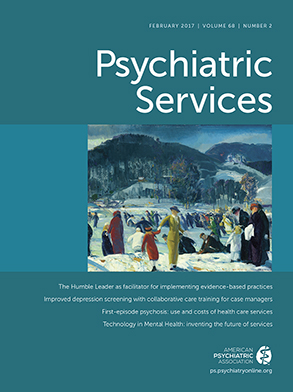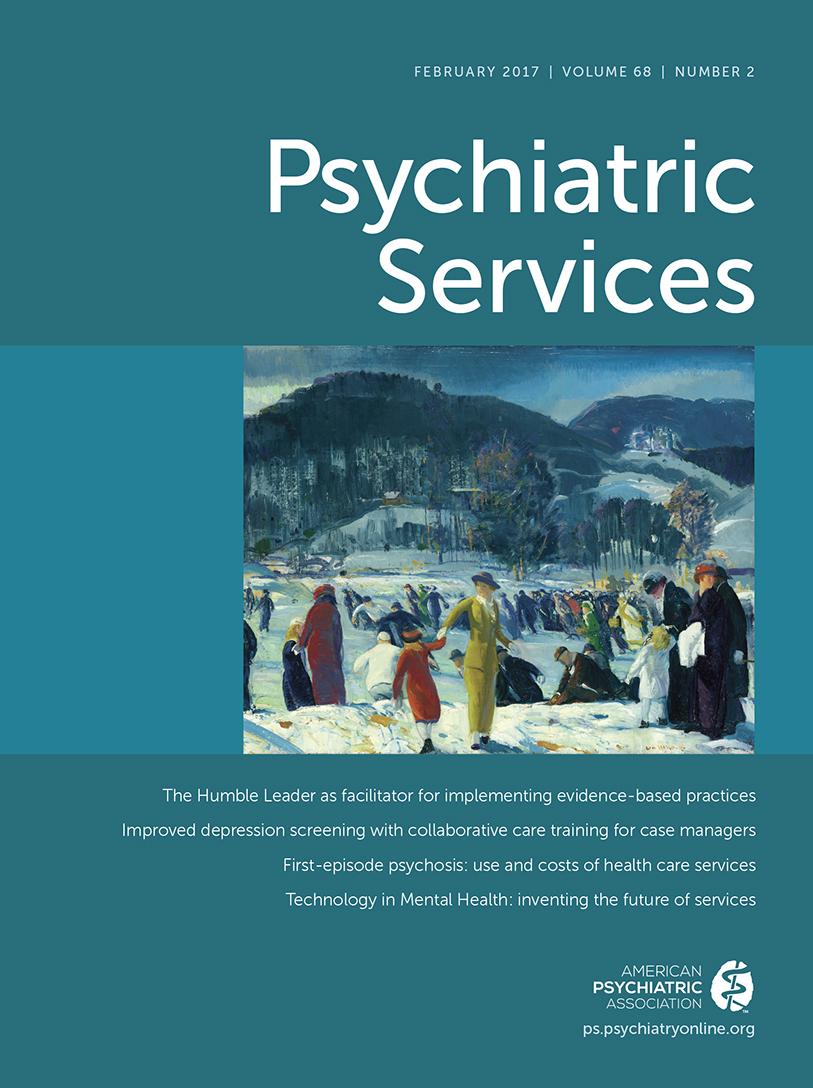Human trafficking is the recruitment of people—through deception, threat, coercion, or other means—for the purposes of exploitation (
1). It is frequently characterized by psychological, physical, or sexual abuse (
2), and trafficked people often experience posttraumatic stress disorder (PTSD), depression, and anxiety (
3–
5). They are also at heightened risk of substance abuse and other self-destructive and risk-taking behaviors (
6). Yet empirical research examining self-harm among trafficked adults is lacking. Recently, Kiss and others (
7) reported a high prevalence of past-month suicide attempts among trafficked adults (5%) and children (5%) who were in contact with posttrafficking services in Cambodia, Thailand, and Vietnam and of past-month self-harm among trafficked children in the same region.
To date, however, there have been no published studies examining self-harm among trafficked adults or among trafficked people who are in contact with mental health services (
8). This is a notable gap because the link between trafficking and self-destructive behaviors—and the association between self-harm and subsequent suicide (
9)—may place this population at heightened risk of early mortality.
Using data from a historical cohort study, this study aimed to estimate the prevalence and correlates of self-harm among adult victims of trafficking who had accessed secondary mental health services in London, to examine mental health service responses to self-harm among adult victims of trafficking, and to compare mental health service responses to self-harm between patients who had and had not been trafficked.
Methods
Data were collected as part of a historical cohort study of trafficked patients and a matched sample of nontrafficked patients who were in contact with secondary mental health services at South London and Maudsley (SLaM) National Health Service Foundation Trust between January 1, 2006, and July 31, 2012.
Data were obtained from the Case Records Interactive Search (CRIS) system, which allows the searching and retrieval of pseudo-anonymized full patient records (
10). We searched for cases involving SLaM patients whose care team had recorded concerns that they may have been trafficked. Terms used to search CRIS records included “victim of trafficking,” “sex trafficking,” “trafficked,” “traffiked,” “trafiked,” “sex traffickers,” “human trafficking,” “forced prostitution,” “child trafficking,” “people trafficking,” “forced labour,” “trafficking,” “sexual slavery,” and “Poppy Project” (an organization in the United Kingdom providing support, advocacy, and accommodation to trafficked women).
Eligibility was assessed by reviewing patients' clinical notes and correspondence between the health care team and other professionals involved in the patients' care. Records were screened against the study inclusion criteria by using the United Nations definition of human trafficking (the recruitment or movement of people, by means such as force, fraud, coercion, deception, and abuse of vulnerability, for the purposes of exploitation) and included both international and internal trafficking (
1). One researcher assessed eligibility, and a second researcher (SO) independently assessed the first ten records and an additional 10% of records chosen at random. Full details are provided elsewhere (
5).
A matched cohort of nontrafficked adult patients was produced by using computer-generated random selection from all potential control patients who met matching criteria. Up to four control patients were selected per case of trafficked patient. Trafficked patients and control patients were matched for gender, age (±2 years), primary diagnosis, psychiatric inpatient admission at first contact, and year of most recent service contact.
Data for sociodemographic, clinical, and service use characteristics were extracted (as described more fully elsewhere [
5]). The following terms, derived from the self-harm literature (
11), were used to search electronic health records for references to self-harm: “self-harm,” “self harm,” “DSH,” “suicid*,” “overdos*,” “electrocut*,” “hang*,” “ligature*,” “burn*,” “lacerat*,” and “cut.” Data for self-harm prior to and during contact with SLaM services and for emergency department visits and psychiatric inpatient admissions (voluntary and compulsory) following self-harm, were extracted by an author (SO).
Logistic regression models were fitted to compare prevalence of, and service responses to, self-harm by trafficked and nontrafficked patients. A random intercept was used for the match identifier to allow for possible correlation between matched individuals. Models comparing self-harm among trafficked and nontrafficked patients while they were accessing SLaM care included the duration of time in contact with SLaM services as an a priori confounder (calculated by subtracting date of first referral from date of final discharge, excluding any periods between referrals, with an upper date limit [the latest possible date for including data] of January 24, 2013). Models comparing trafficked and nontrafficked patients’ emergency department attendance and psychiatric admissions after self-harm included history of self-harm prior to contact with SLaM and the duration of time in contact with SLaM services. Given that less than 10% of data were missing for all variables included in logistic regression models, complete case analysis was used. Ethics approval was granted by an independent Research Ethics Committee (Oxfordshire C, reference 08/H0606/71). The CRIS Oversight Committee gave approval for this study (11/025).
Results
Ninety-eight trafficked patients were identified. Data are reported for the 84 trafficked patients who had a recorded ICD-10 diagnosis and could be compared with a matched sample of nontrafficked adults. Most trafficked patients were female (N=66, 79%) and ages 18 to 45 (N=83, 99%; mean±SD age=26.9±6.8) and had been trafficked for the purpose of sexual exploitation (N=46, 55%). All 84 had escaped the trafficking situation. Data for type of exploitation were missing for 22 (26%) patients.
Trafficked patients originated from 33 countries, with Nigeria (N=16, 19%), China (N=7, 8%), and Uganda (N=7, 8%) jointly accounting for more than one-third of all patients. The most prevalent diagnoses were affective disorders (N=33, 39%); PTSD, severe stress, or adjustment disorder (N=27, 32%); and schizophrenia and related disorders (N=14, 17%). A majority of trafficked patients were referred for care following contact with other health services, including primary care (N=29, 35%), emergency departments (N=25, 30%), and maternity services (N=8, 10%). Other sources of referral included the police and the voluntary sector.
Table 1 summarizes the self-harm data from matched samples of trafficked (N=84) and nontrafficked (N=287) patients. Almost one-third of trafficked patients (33%) reported a history of self-harm prior to SLaM contact. One-quarter (25%) engaged in self-harm while under the care of SLaM; of those, 13 (62%) had a history of self-harm recorded in their notes. Of the 21 trafficked patients who engaged in self-harm while under SLaM care, 57% were admitted as a psychiatric inpatient following self-harm, and 29% were compulsorily detained. Ten (48%) trafficked patients who engaged in self-harm had a diagnosis of an affective disorder, and five (24%) had a diagnosis of PTSD, severe stress, or adjustment disorder. Self-poisoning (43%), attempted hanging (29%), and cutting or burning (24%) were frequently reported methods of self-harm among trafficked patients.
Medical records included information about the circumstances of self-harm for 18 of the 21 trafficked patients who engaged in self-harm while under SLaM care. Several trafficked people were described as experiencing low mood and feelings of failure and hopelessness, with no specific trigger identified. Others were described as experiencing command hallucinations instructing them to engage in self-harm or as wanting to escape intrusive thoughts and distress related to their experiences while trafficked. Other triggers included refusal of claims for immigration protection, participation in criminal proceedings against traffickers, impending eviction, relationship difficulties, and financial problems.
The prevalence of history of self-harm did not differ significantly between trafficked and nontrafficked adults. Similarly, the prevalence of self-harm while under the care of SLaM services did not differ significantly between trafficked and nontrafficked adults. However, trafficked adults were significantly less likely than nontrafficked adults to have visited an emergency department after engaging in self-harm (adjusted odds ratio [AOR]=.47), but they were more likely to be admitted as psychiatric inpatients after engaging in self-harm (AOR=2.81) and to be compulsorily admitted as psychiatric inpatients after engaging in self-harm (AOR=28.75).
Discussion
The prevalence of recorded self-harm among trafficked adults who were receiving secondary mental health care from SLaM was high, although no higher than for a matched sample of nontrafficked adult SLaM patients. However, trafficked and nontrafficked patients who engaged in self-harm experienced different mental health service responses. Trafficked patients were more likely than nontrafficked patients to be admitted as psychiatric inpatients—and to be compulsorily admitted—following an episode of self-harm. This is an important finding. Compulsory admission is beneficial in many cases and reflects experienced clinical judgment—yet it may be particularly distressing for trafficked people, who may have experienced restrictions on their movements and controls on their daily routines during the course of their exploitation.
By contrast, trafficked patients were less likely than nontrafficked patients to visit an emergency department following self-harm. This may be a function of the nature and severity of the self-harm episodes but may also reflect patients’ limited knowledge of the health system in the United Kingdom, patients’ experiences with care in their home countries (especially regarding the cost of care), or other factors that are not yet understood. The medical records of the trafficked patients included basic information about the precipitants of self-harm, including distress relating to their experiences while trafficked and legal, financial, and social stressors. In previous research with this cohort, mental health professionals highlighted the negative effects of similar stressors on trafficked persons’ mental health, in particular ongoing or failed asylum claims and a lack of stable accommodation (
12). Further research is needed to explore risks and protective factors associated with self-harm, immediate precipitants of self-harm that may be particular to trafficked adults, and appropriate mental health service responses.
Ross and colleagues (
13) recently found that 81% of mental health professionals in the United Kingdom reported having received insufficient training to adequately assist trafficked people, even though up to one in seven professionals may have had contact with a person they knew or suspected had been trafficked. It is imperative that mental health professionals understand the issues surrounding human trafficking and are equipped adequately to identify and respond to trafficked people. An enhanced understanding of trafficking may contribute to the implementation of a wider range of treatment options following self-harm.
These are the first published data about self-harm among trafficked adults and in a clinical sample of trafficked people internationally. The data source allowed us to make detailed comparisons between trafficked and nontrafficked patients across a range of outcomes of interest, including service responses to self-harm.
Our study also had some limitations. First, most participants were female and because self-harm is more common among females (
11), our findings may not be generalizable to male victims of trafficking. Second, data did not support detailed qualitative analysis, for example, of precipitants of self-harm, and because we extracted the data from a pseudo-anonymized psychiatric case register, it was not possible to collect supplementary data through patient interviews.
Conclusions
The findings of this study demonstrate that self-harm was common among trafficked adults who accessed secondary mental health services in England. Mental health professionals must address human trafficking as a serious health risk because, like other forms of violence, it is associated with considerable psychological and physical harm, including self-harm. Given the extreme nature and severe consequences of trafficking, mental health professionals have a crucial role to play in supporting survivors, including through the assessment and prevention of self-harm and suicide, and in ensuring sensitive and humane responses to self-harm.

